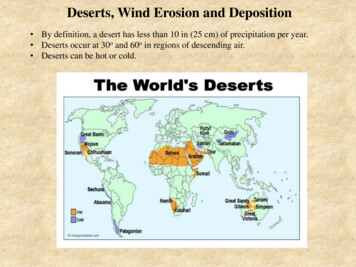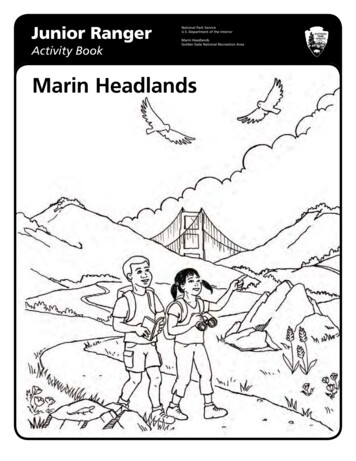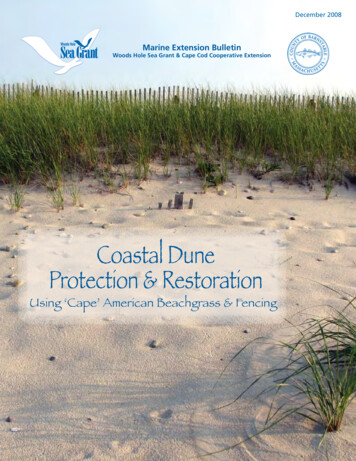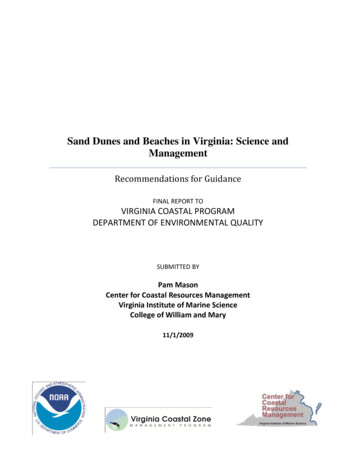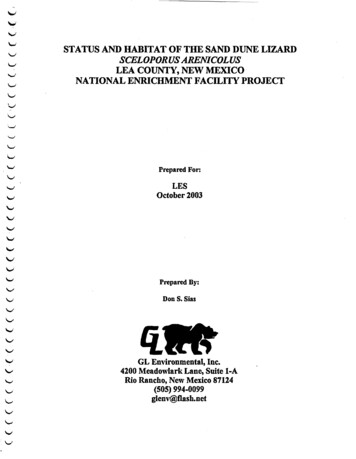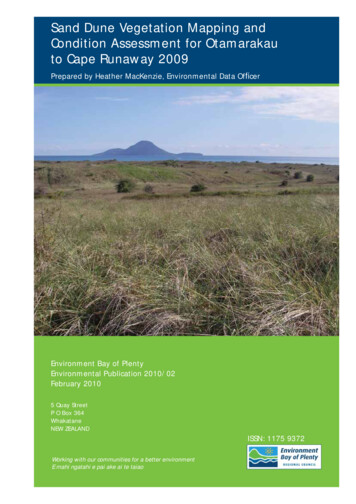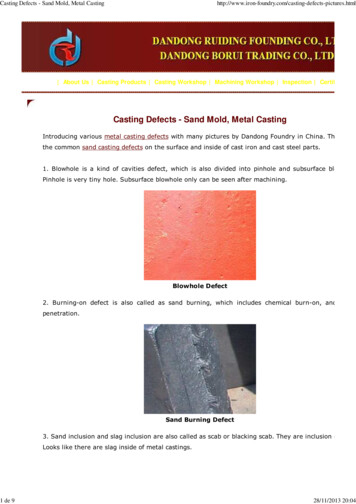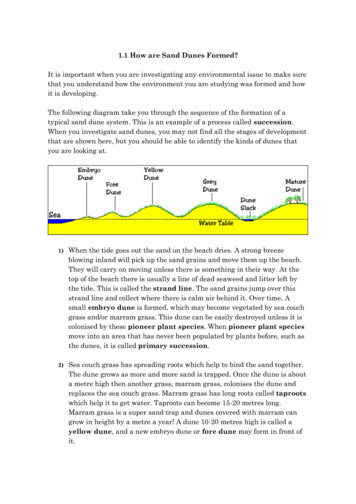
Transcription
1.1 How are Sand Dunes Formed?It is important when you are investigating any environmental issue to make surethat you understand how the environment you are studying was formed and howit is developing.The following diagram take you through the sequence of the formation of atypical sand dune system. This is an example of a process called succession.When you investigate sand dunes, you may not find all the stages of developmentthat are shown here, but you should be able to identify the kinds of dunes thatyou are looking at.1)When the tide goes out the sand on the beach dries. A strong breezeblowing inland will pick up the sand grains and move them up the beach.They will carry on moving unless there is something in their way. At thetop of the beach there is usually a line of dead seaweed and litter left bythe tide. This is called the strand line. The sand grains jump over thisstrand line and collect where there is calm air behind it. Over time, Asmall embryo dune is formed, which may become vegetated by sea couchgrass and/or marram grass. This dune can be easily destroyed unless it iscolonised by these pioneer plant species. When pioneer plant speciesmove into an area that has never been populated by plants before, such asthe dunes, it is called primary succession.2)Sea couch grass has spreading roots which help to bind the sand together.The dune grows as more and more sand is trapped. Once the dune is abouta metre high then another grass, marram grass, colonises the dune andreplaces the sea couch grass. Marram grass has long roots called taprootswhich help it to get water. Taproots can become 15-20 metres long.Marram grass is a super sand trap and dunes covered with marram cangrow in height by a metre a year! A dune 10-20 metres high is called ayellow dune, and a new embryo dune or fore dune may form in front ofit.
3)Dunes have a typical form, the windward side is gentle sloping and shapedby wind movement. The leeward side faces away from the shore and issteeper and unstable.4)Once a yellow dune is about 10 metres high then conditions at the leewardside become less windy and less sand builds up immediately behind it.When marram grass dies, it decays on the dune adding humus to the sand.This humus and sand combination forms a soil in which other plants areable to grow. These may include dandelions and rest harrow. This kind ofdune is called a semi-fixed dune.5)As time goes by the soil depth increases and it becomes damper and richer.More and more plants are found, some of which are small and delicatesuch as lichens, mosses, wild thyme, and bird’s foot trefoll may beencountered. The plants form a continuous cover over the sand. This iscalled a fixed dune or a grey dune. The name grey dune comes from thecolour of the mosses which often give the dune a grey appearance. Marramgrass disappears from this area of the dunes. It is usually replaced by redfescue grass.6)As the dune system gets older and larger, water can collect in some of thehollows towards the back of the dune. These hollows are known as duneslacks and here marsh plants and small willow trees can grow. This is oneof the final stages of the sand dune ecosystem and will lead to climaxvegetation in absence of management or other influences such as fires,trampling and so-on.7)Biodiversity increases inland as more and more plants colonise the dunesystem. The climax community is the typical climax community of theclimate. In the UK this is Oak, Beach and Birch tree varieties. When thisclimax community develops into a forest, it is called a hardwood forest.8)When the climax community burns down due to natural disaster, or is cutdown for logging purposes. The barren land will be populated by newpioneer species. This kind of succession is called secondary succession.The pioneer species that move into an area like this will most likely begrasses and weeds. If the area is sheltered young maple trees will populatethe area as well.
1.2 Pioneer Plant SpeciesPioneer species are hardy species which are the first to colonize previouslydisrupted or damaged ecosystems, beginning a chain of ecological succession thatultimately leads to a more bio-diverse steady-state ecosystem. Since uncolonizedland may have thin, poor quality soils with few nutrients, pioneer species areoften hardy plants with adaptations such as long roots, root nodes containingnitrogen-fixing bacteria, and leaves that employ transpiration. Eventually,pioneer species will die creating plant litter, and break down as "leaf mold" aftersome time, making new soil (humus) for other plants to grow on.Marram GrassThis grass is found almost exclusively on the first line of coastalsand dunes. Marram grass is able to tolerate the poor waterretention of the soil (sand) and the drying effects of wind bymaximizing water uptake and limiting water loss.-RootsThe extensive systems of creeping underground stems, also calledrhizomes, allow them to thrive under conditions of shifting sandsand high winds, and to help stabilize and prevent coastal erosion.Marram grass also possesses taproots up to thirty feet long and iskey to stabilizing beaches and sand dunes.-LeavesThis is a cross section of amarram grass leaf. Note thethick waxy upperepidermis (cuticle) extendsall the way around as theleaf rolls up. This places thestomata (leave openings,pores) in an enclosed spacenot exposed to the wind.Note that the stomata are inpits which allows boundarylayer of humidity to build up which also reduces water loss byevaporation. The hairs on the inner surface also allow water vapour to beretained which reduces water loss through the pores. The groove formed by therolled leaf also acts as a channel for rain water to drain directly to the specificroot of the grass stem.
Prickly saltwort (Salsola kali) isanother example of a pioneer.It is low-growing, so avoids sandladen winds, it is tolerant of burial bysand, with an extensive root system.The leaves have a waxy cuticle justlike Marram Grass has, which helpsto reduce transpiration. The leavesand stems are succulent (fleshy) tohelp store water. These parts alsohave a high salt content, ensuringthat the roots have a low osmoticpotential (which means they take upwater well).Sea spurge (Euphorbia paralias) is a low-growingplant sometimes found on the seaward side of mobiledunes. It has succulent leaves and stems – the tissueshave a low osmotic potential and can absorb water fromthe salty sand. It has thick leathery leaves with a waxycuticle to reduce water loss by transpiration and protectagainst abrasive sand-laden winds.Sea spurge can tolerate shallow burial in sand.Although buried leaves die, and leave a scar, thisstimulates the growth of new leaves from the base. Overtime, a clump is formed.
1.3 Biodiversity throughout the sand dunes"Biodiversity describes the number and variety of all forms of life living organisms, the genetic differences between them and theecosystems in which they occur."A community dominated by one or two species is considered to be less diversethan one in which several different species have a similar abundance. Whenyou walk through the dunes from the strandline towards the climax communitymore inland, you can see that more and more different species start to appearas you go further inland. In other words, the biodiversity increases. This isbecause conditions become friendlier as you move more inland: the soil isricher, the water isn’t as salty, the wind isn’t as strong and so on.In a climax community however, where there are lots of big trees, thebiodiversity tends to decrease again. This is because all the smaller plants andthe big trees compete for nutrients/minerals, water, and light. The treesgenerally win this battle and crowd out the smaller plants.Simpson's Diversity Index is a measure of diversity which takes into accountthe number of species present, as well as the relative abundance of eachspecies. As species richness and evenness increase, so diversity increases.n the total number of organisms of a particular speciesN the total number of organisms of all speciesThe value of D ranges between 0 and 1. With this index, 1 represents infinitediversity and 0, no diversity.The Diversity Index is a relative number.
Review ExercisesA. True or False?As sand dunes develop:The soil gets richerThere are fewer types of plants to be foundThe sand dunes get higherThere is less bare sand to be foundThe soil gets moisterThey are more resistant to people trampling over themThey cover a larger areaThe soil is more saltyThere is more animal lifeThere are more treesT/F?B. Gap FillsWrite the term that best completes each statement in the space provided.1. A gradual change in the populations of organisms that occurs when theenvironment changes is called2. As plant populations change, differentpopulations move in.3. In succession, the first populations to change are thepopulations.4. The last community in a succession is the community.5. Oak and maple trees are most likely to be found in a forest.6. If a forest burns down, the first organisms to grow in the burnt area are likelyto be and .
C. SkillsSand Dune Vegetation -- Although sand dune succession processes are thesame wherever you go, the types of vegetation you will find on those sand dunesis different in different parts of the world. The diagram on the next page showsthe types of plans you might find in a sand dune ecosystem on new Zealand’sNorth Island.
Your Task: From the strandline to the climax community, write down whichplants you might find in the sand dunes in Wassenaar:12345678910111213New ZealandSpinifexPrgaoShore bindweedWiwiSand DaphnePohuehueSand CoprosmaSand SedgeRaxToe toeCabbage TreeSand kanukaPofiutukawaWassenaarPlant Word Bank (of course you can also use other plants)Marram grass, Sand Couch, Saltwort, Bramble, Birch, Maple, Dandelion, Nettle,Heather, Sea Holly, Blue Weed, Sea Buckthorn, Common Cat’s Ear, Sand Sedge,Gorse, Ragwort, Creeping Willow, Birdsfoot Trefoil, Moss, Alder.
Field WorkSamplingIf you want to study an ecosystem such as a sand dune (psammosere), lithosere,hydrosere or a saltmarsh, you probably won’t be able to study the entire area dueto time / size constraints (or the high probability of complete boredom setting in).Therefore you will need to sample from the ecosystem in order to collect data thatis accurate and representative of the area as a whole.ClinometersClinometers are used for investigating the slope profile of the area you areinvestigating.The distance between the poles (D) and the measured angles (e) can be used asshown in the diagram above for calculating the exact horizontal and verticaldistance covered. You will need this to make an accurate transect for a posterpresentation. (In class we cheated by assuming the horizontal distance was thesame as the distance between the poles.)
Measuring biotic factors: QuadratsWhen carrying out any form of vegetation sampling, one piece of equipment youwill almost certainly require is a quadrat. Quadrats are defined simply assampling areas, and can therefore be of almost any shape, size and type. For yourinvestigation you used an area of 1x1 metres.Example of a quadrat outcome:SpeciesNumber (n)Sea holly2Sand couch8Sea bindweed1Sporobolus pungens1Echinophora spinosa3Total15n 15Measuring biotic factors: Simpson’s Diversity IndexAs explained in section 1.3, the biodiversity of an area can be quantified byusing Simpson’s Diversity Index. As an example, let us work out the value of Dfor a single quadrat sample of ground vegetation in the dunes in Wassenaar. Ofcourse, sampling only one quadrat would not give you a reliable estimate of thediversity of the dune flora. Several samples would have to be taken and thedata pooled to give a better estimate of overall diversity.SpeciesNumber (n)n(n-1)Sea holly22Sand couch856Sea bindweed10Sporobolus pungens10Echinophora spinosa361564N 15n(n-1) 64Total
Putting the figures into the formula for Simpson's Index:Simpson's Index of Diversity for this area 0.7Measuring biotic factors: Capture/Mark/Release and RecaptureThe Lincoln-Peterson Method provides a way to measure population sizes ofindividual animal species. In theory, mark / recapture techniques involvesampling a population of animals and then marking all of the individualscaptured in a recognizable way. The marked animals are then released back intothe population and left to mingle for a suitable period of time. Once they havebecome thoroughly mixed into the population again, the population is resampled. The assumption is then made that the proportion of marked animals inthe second sample is the same as the proportion of marked animals to nonmarked within the whole population. Enough time must be allowed to elapse forcomplete mixing to have occurred.In order to calculate an estimate for the true population size, the followingformula is used:Total animals in first capture Total animals recapturedPopulation estimate otal marked animals in recaptured sampleBeetlesNumber (n)Captured and marked infirst round20Captured in secondround30Marked in second roundPopulation Estimate220*30/2Population size 300beetles in this area
This method is based on four assumptions: (1) The chance of capture is the samefor all individuals, marked or unmarked, in both samples. (2) The populationdoes not change in size between samples. Thus, no birth, death, immigration, oremigration occurs. This is necessary to keep the ratio of tagged to untaggedindividuals constant (3) Marked individuals have time to distribute themselvesrandon-dy within the population before the second sampling. (4) Marks or tagsare not lost between samples.Measuring abiotic factorsEnvironmental conditions are important to consider when conducting fieldwork,as changes in vegetation are often as a response to changes in the physical andchemical environment. Non-living environmental factors are known as abioticfactors, and can include light, temperature, water, atmospheric gases, wind,humidity, and soil conditions to name but a few. Abiotic factors cannot becontrolled, however they can (and should) be monitored. Methods for measuringabiotic factors vary greatly according to the time and equipment available. Theresults are often compiled in tables.
Field Work Questions1. Two students conducted a field study at different locations in the dunes inWassenaar. Use their data in the table below to calculate: The Biodiversity Indexof the area and the Population Size of the ladybugs they captured at the differentlocations.Plants1234LadybugsCaptured andmarked (1)Captured (2)Marked in secondcaptureLocation 11021-Location 225423731101Biodiversity Index Location 1 Biodiversity Index Location 2 Population Size Ladybugs Location 1 Population Size Ladybugs Location 2 2. Which location do you think is closer to the beach? Explain your answer.3. List and explain at least two factors that could possibly affect capture/recaptureresults in this study of a ladybug population size.
Another example of Succession:Succession in a Pond EcosystemSuccession, a series of environmental changes, occurs in all ecosystems. Thestages that any ecosystem passes through are predictable. In this activity, youwill place the stages of succession of two ecosystems into sequence. You will alsodescribe changes in an ecosystem and make predictions about changes that willtake place from one stage of succession to another.The evolution of a body of water from a lake to a marsh can last for thousands ofyears. The process cannot be observed directly. Instead, a method can be used tofind the links of stages and then to put them together to develop a complete story.The water level of Lake Michigan was once 18 meters higher than it is today. Asthe water level fell, land was exposed. Many small lakes or ponds were leftbehind where there were depressions in the land. Below are illustrations anddescriptions of four ponds as they exist today.Use the illustrations and descriptions to answer the questions about the ponds.Pond A: Cattails, bulrushes, andwater lilies grow in the pond. Theseplants have their roots in the bottom ofthe pond, but they can reach above thesurface of the water. This pond is anideal habitat for the animals that mustclimb to the surface for oxygen.Aquatic insect larvae are abundant. They serve as food for larger insects, whichin turn are food for crayfish, frogs, salamanders, and turtles.Pond B: Plankton growth is richenough to support animals thatentered when the pond was connectedto the lake. Fish make nests on thesandy bottom. Mussels crawl over thebottom.Pond C: Decayed bodies of plants and animalsform a layer of humus over the bottom of thepond. Chara, a branching green algae, coversthe humus. Fish that build nests on the barebottom have been replaced by those that laytheir eggs on the Chara.
Pond D: The pond is so filled withvegetation that there are no longer anylarge areas of open water. Instead, thepond is filled with grasses. The waterdries up during the summer months.Questions1. Write the letters of the ponds in order from the youngest, to the oldest.2. Black bass and bluegill make their nests on sandy bottoms. In which pondwould you find them?3. What will happen to the black bass and blue gill as the floor of the ponds fillswith organic debris?4. Golden shiner and mud minnows lay their eggs on Chara. In which pond wouldyou find them?5. Some amphibians and crayfish can withstand periods of dryness by buryingthemselves in mud. In which pond(s) would they survive?6. Dragonfly nymphs spend their early stages clinging to submerged plants.Then, they climb to the surface, shed their skins and fly away as dragonflies.Which pond is best suited for dragonflies?7. In which pond will gill breathing snails be replaced by lung breathing snailsthat climb to the surface to breathe?8. Some mussels require a sandy bottom in order to maintain an upright position.In which pond will they die out.
The climax community in the area of Michigan is a beech-maple forest. After theponds are filled in, the area will undergo another series of stages of succession.This is illustrated below. Briefly explain what is happening in the diagram.Stage:1.2.3.4.5.
called a fixed dune or a grey dune. The name grey dune comes from the colour of the mosses which often give the dune a grey appearance. Marram grass disappears from this area of the dunes. It is usually replaced by red fescue grass. 6) As the dune system gets older and larger, water can collect in some of the hollows towards the back of the dune.
